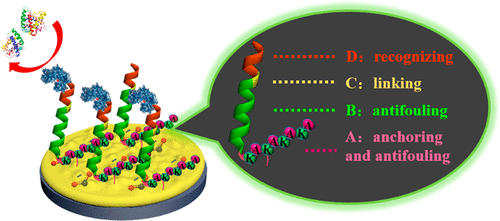当前位置:
X-MOL 学术
›
Anal. Chem.
›
论文详情
Our official English website, www.x-mol.net, welcomes your
feedback! (Note: you will need to create a separate account there.)
Designed Three-in-One Peptides with Anchoring, Antifouling, and Recognizing Capabilities for Highly Sensitive and Low-Fouling Electrochemical Sensing in Complex Biological Media.
Analytical Chemistry ( IF 6.7 ) Pub Date : 2020-03-31 , DOI: 10.1021/acs.analchem.9b05299 Zhen Song 1 , Min Chen 1 , Caifeng Ding 1 , Xiliang Luo 1
Analytical Chemistry ( IF 6.7 ) Pub Date : 2020-03-31 , DOI: 10.1021/acs.analchem.9b05299 Zhen Song 1 , Min Chen 1 , Caifeng Ding 1 , Xiliang Luo 1
Affiliation

|
Nonspecific adsorption is of great concern for electrochemical biosensors performing in complex biological media, and various antifouling materials have been introduced into the sensing interfaces to improve the antifouling capability of different biosensors. However, for most of the biosensors with antifouling materials and sensing probes coexisting in the sensing interfaces, either the antifouling materials will impair the sensing performances or the sensing probes will affect the antifouling ability. Herein, a facile and efficient antifouling biosensor was developed based on a newly designed three-in-one peptide with anchoring, antifouling, and recognizing capabilities. One end of the designed peptide is a unique anchoring part that is rich in amine groups, and this part can be anchored to the poly(3,4-ethylenedioxythiophene) (PEDOT)-citrate film electrodeposited on a glassy carbon electrode. The other end of the peptide is a recognizing part that can specifically bind to the aminopeptidase N (APN) and human hepatocellular carcinoma cells (HepG2 cells). Meanwhile, the middle part of the peptide, together with the anchoring part, was designed to be antifouling. With this designed multifunctional peptide, highly sensitive and low-fouling biosensors capable of assaying target APN and HepG2 cells in complex biological media can be easily prepared, with detection limits of 0.4 ng·mL-1 and 20 cells·mL-1, respectively. This antifouling biosensor is feasible for practical target detection in real complex samples, and it is highly expected that this peptide designing strategy may be extended to the development of various antifouling biosensors.
中文翻译:

设计具有锚定,防污和识别功能的三合一多肽,可在复杂生物介质中实现高灵敏度和低污损的电化学传感。
对于在复杂生物介质中运行的电化学生物传感器而言,非特异性吸附非常重要,并且已将各种防污材料引入传感界面以提高不同生物传感器的防污能力。然而,对于大多数带有防污材料和传感探针共存于传感界面的生物传感器,防污材料会损害传感性能,或者传感探针会影响防污能力。在此,基于新设计的具有锚定,防污和识别能力的三合一肽,开发了一种简便有效的防污生物传感器。设计肽段的一端是一个独特的锚定部分,该部分富含胺基,该部分可以锚定到poly(3,电沉积在玻璃碳电极上的柠檬酸4-乙二氧基噻吩(PEDOT)膜。肽的另一端是可与氨基肽酶N(APN)和人肝细胞癌细胞(HepG2细胞)特异性结合的识别部分。同时,肽的中间部分以及锚定部分被设计为防污。使用这种设计的多功能肽,可以轻松制备能够检测复杂生物介质中目标APN和HepG2细胞的高灵敏度,低污染生物传感器,其检测限分别为0.4 ng·mL-1和20细胞·mL-1。该防污生物传感器对于实际的复杂样品中的实际目标检测是可行的,并且高度期望该肽设计策略可以扩展到各种防污生物传感器的开发。
更新日期:2020-04-23
中文翻译:

设计具有锚定,防污和识别功能的三合一多肽,可在复杂生物介质中实现高灵敏度和低污损的电化学传感。
对于在复杂生物介质中运行的电化学生物传感器而言,非特异性吸附非常重要,并且已将各种防污材料引入传感界面以提高不同生物传感器的防污能力。然而,对于大多数带有防污材料和传感探针共存于传感界面的生物传感器,防污材料会损害传感性能,或者传感探针会影响防污能力。在此,基于新设计的具有锚定,防污和识别能力的三合一肽,开发了一种简便有效的防污生物传感器。设计肽段的一端是一个独特的锚定部分,该部分富含胺基,该部分可以锚定到poly(3,电沉积在玻璃碳电极上的柠檬酸4-乙二氧基噻吩(PEDOT)膜。肽的另一端是可与氨基肽酶N(APN)和人肝细胞癌细胞(HepG2细胞)特异性结合的识别部分。同时,肽的中间部分以及锚定部分被设计为防污。使用这种设计的多功能肽,可以轻松制备能够检测复杂生物介质中目标APN和HepG2细胞的高灵敏度,低污染生物传感器,其检测限分别为0.4 ng·mL-1和20细胞·mL-1。该防污生物传感器对于实际的复杂样品中的实际目标检测是可行的,并且高度期望该肽设计策略可以扩展到各种防污生物传感器的开发。











































 京公网安备 11010802027423号
京公网安备 11010802027423号